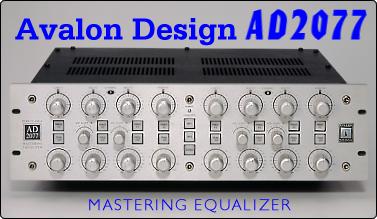
|
REVIEWS: |
|
AUDIO MEDIA DECEMBER 1997 The AD2077 mastering equalizer is, in the words of Avalon, 'an ultraistic design, optimizing absolute signal integrity with musical performance'. BENEDICT GRANT takes an exclusive look at this flagship product of the Avalon range. To describe this product as robustly built would be an understatement. I have encountered
Facilities The mastering equalizer is a two-channel unit, with four bands of equalization per channel. I/O is electronically balanced, and the equalizer has massive headroom, with maximum I/O levels of +30dBu. Avalon's published specification states a noise measurement of -92dBu with the equalizer in (20kHz, unweighted), and THDSN of 0.05 percent at +10dB. Slew rate is 75 volts per microsecond, and frequency response, with the equalizer switched in circuit, is 5Hz to 100kHz (±0.5dB). All circuitry is fully discrete, with pure class-A signal amplifiers. It employs auto-bias DC servo loop control, eliminating the need for AC bias between stages, and creating the most direct signal paths. The output stages are fully balanced, DC-coupled high-voltage class-A line 3rivers. Hard wire bypass switching is accomplished by sealed relays. The equalizer comprises four filters per channel. These are labeled F1 to F4. F1 and F4, the high and low bands, are passive designs. Each can be switched to operate at any one of ten frequencies. These range from 18Hz to 440Hz for F1, and from 3kHz to 25kHz for F4. On each of these bands up to 10dB of boost or cut may be selected in one-decibel steps or, by pressing the adjacent X2 switch, up to 20dB in two-decibel steps. These filters have a slope of 6dB per octave, and may be switched between a shelving and bell (peak/dip) response. Filters F2 and F3 are fully parametric, active filters, with a bell-shaped (peak/dip) response and, between them, they cover the range of 12Hz to 24kHz. They are similar filters, the only difference being in the frequency range covered. Filter F2 can be set to operate at any of 21 frequencies in the range of 12Hz to 400Hz, or, when the adjacent X10 switch is pressed, the range of 120Hz to 4kHz. Filter F3 operates over the range of 140Hz to 2.4kHz; 1.4kHz to 24kHz when X10 is selected. Each can provide up to 5dB of boost or cut in steps of 0.5dB, or up to 10dB at a resolution of 1dB per step when the appropriate X2 switch is pressed. The slope of each filter may be switched to 6dB, 9dB, 12dB, 15dB or 18dB per octave - effectively a Q control under a different name. Evaluation The AD2077 is an absolute delight to use. This equalizer is sonically almost transparent - a result, no doubt, of the carefully biased class-A circuitry, and minimal signal path design philosophy. It is a very powerful processor that is, nevertheless, subtle in effect - I found it possible to add large amounts of boost, even in the upper-mid region, without introducing any unpleasant harshness to the sound. This is not, of course, the purpose of a mastering equalizer, although it is a testament to the quality of its design.I was impressed by the precise calibration of the controls: on most equalizers one turns the knobs until the sound is right but, because of the poor calibration of controls, is never quite sure in numerical terms what EQ has been applied. With the AD2077 one is in no doubt as to exactly how much boost or cut has been applied, and at what frequency and Q. It is, of course, a further function of having switched controls rather than potentiometers that settings are repeatable. While the AD2077 is a flagship product, it is also, in some ways, a minimalist one. It has no superfluous facilities, but it also lacks some features found almost routinely on much cheaper products - for example there are no high- and low-pass filters, which I have frequently found invaluable at the mastering stage, neither is there any form of metering, not even an LED to indicate the presence of a signal. The absence of high- and low-pass filters may be excused because of the large amount of overlap between filters F1 and F2, and F3 and F4. However, I can recall many occasions when, while mastering, I have needed to use a high-pass filter in addition to four bands of EQ. I am less happy about the omission of a signal present indicator. Conclusion This is truly a Rolls-Royce product, impeccably designed and performing to the highest standard. For any studio which demands the best, and can afford the hefty price, the AD2077 is sure to prove a rewarding investment, and is, undoubtedly, a future classic.Back to Reviews Index & User List |
Tel: +1 949 492
2000
©2023 Avalon Design USA LLC
 power amplifiers which were lighter than the 35 pounds of this equalizer. The case is made of
heavy gauge steel, 3U high, and with a large heat sink at the rear. The front panel is a
massive block of brushed aluminum with Avalon's logo etched deeply into it. All the rotary controls are multi-way switches (rather than potentiometers), with gold-plated contacts. The knobs - also solid aluminum - are chunky and easy to grasp, with deep knurling. An external power supply unit is linked to the equalizer rack by means of a four-pin XLR to XLR cable.
power amplifiers which were lighter than the 35 pounds of this equalizer. The case is made of
heavy gauge steel, 3U high, and with a large heat sink at the rear. The front panel is a
massive block of brushed aluminum with Avalon's logo etched deeply into it. All the rotary controls are multi-way switches (rather than potentiometers), with gold-plated contacts. The knobs - also solid aluminum - are chunky and easy to grasp, with deep knurling. An external power supply unit is linked to the equalizer rack by means of a four-pin XLR to XLR cable.